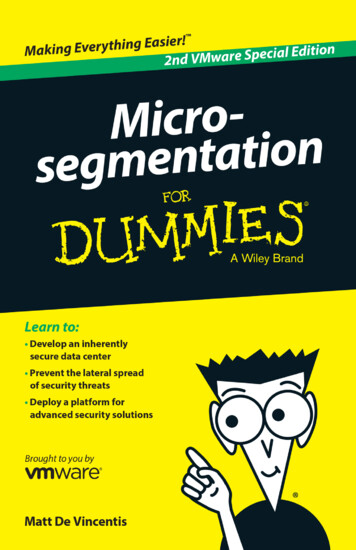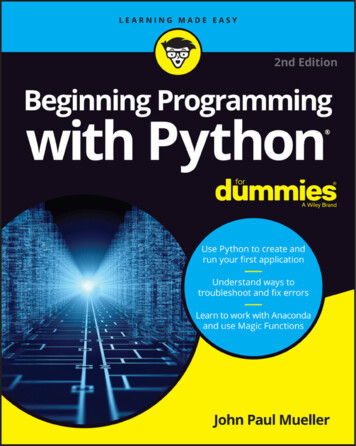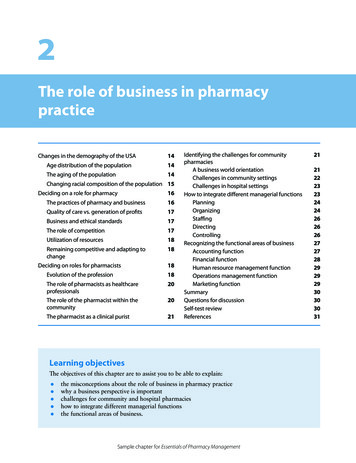
Transcription
These materials are 2017 John Wiley & Sons, Inc. Any dissemination, distribution, or unauthorized use is strictly prohibited.
Micro‐segmentation2nd VMware Special Editionby Matt De VincentisThese materials are 2017 John Wiley & Sons, Inc. Any dissemination, distribution, or unauthorized use is strictly prohibited.
Micro‐segmentation For Dummies , 2nd VMware Special EditionPublished byJohn Wiley & Sons, Inc.111 River St.Hoboken, NJ 07030‐5774www.wiley.comCopyright 2017 by John Wiley & Sons, Inc., Hoboken, New JerseyNo part of this publication may be reproduced, stored in a retrieval system or transmitted in any formor by any means, electronic, mechanical, photocopying, recording, scanning or otherwise, exceptas permitted under Sections 107 or 108 of the 1976 United States Copyright Act, without the prior written permission of the Publisher. Requests to the Publisher for permission should be addressed to thePermissions Department, John Wiley & Sons, Inc., 111 River Street, Hoboken, NJ 07030, (201) 748‐6011,fax (201) 748‐6008, or online at http://www.wiley.com/go/permissions.Trademarks: Wiley, For Dummies, the Dummies Man logo, The Dummies Way, Dummies.com,Making Everything Easier, and related trade dress are trademarks or registered trademarks of JohnWiley & Sons, Inc. and/or its affiliates in the United States and other countries, and may not be usedwithout written permission. All other trademarks are the property of their respective owners. JohnWiley & Sons, Inc., is not associated with any product or vendor mentioned in this book.LIMIT OF LIABILITY/DISCLAIMER OF WARRANTY: THE PUBLISHER AND THE AUTHOR MAKENO REPRESENTATIONS OR WARRANTIES WITH RESPECT TO THE ACCURACY ORCOMPLETENESS OF THE CONTENTS OF THIS WORK AND SPECIFICALLY DISCLAIM ALLWARRANTIES, INCLUDING WITHOUT LIMITATION WARRANTIES OF FITNESS FOR A PARTICULARPURPOSE. NO WARRANTY MAY BE CREATED OR EXTENDED BY SALES OR PROMOTIONALMATERIALS. THE ADVICE AND STRATEGIES CONTAINED HEREIN MAY NOT BE SUITABLE FOREVERY SITUATION. THIS WORK IS SOLD WITH THE UNDERSTANDING THAT THE PUBLISHER ISNOT ENGAGED IN RENDERING LEGAL, ACCOUNTING, OR OTHER PROFESSIONAL SERVICES. IFPROFESSIONAL ASSISTANCE IS REQUIRED, THE SERVICES OF A COMPETENT PROFESSIONALPERSON SHOULD BE SOUGHT. NEITHER THE PUBLISHER NOR THE AUTHOR SHALL BE LIABLEFOR DAMAGES ARISING HEREFROM. THE FACT THAT AN ORGANIZATION OR WEBSITE ISREFERRED TO IN THIS WORK AS A CITATION AND/OR A POTENTIAL SOURCE OF FURTHERINFORMATION DOES NOT MEAN THAT THE AUTHOR OR THE PUBLISHER ENDORSES THEINFORMATION THE ORGANIZATION OR WEBSITE MAY PROVIDE OR RECOMMENDATIONS ITMAY MAKE. FURTHER, READERS SHOULD BE AWARE THAT INTERNET WEBSITES LISTED INTHIS WORK MAY HAVE CHANGED OR DISAPPEARED BETWEEN WHEN THIS WORK WASWRITTEN AND WHEN IT IS READ.ISBN 978‐1‐119‐44854‐9 (pbk); ISBN 978‐1‐119‐45337‐6 (ebk)Manufactured in the United States of America10 9 8 7 6 5 4 3 2 1For general information on our other products and services, or how to create a customFor Dummies book for your business or organization, please contact our BusinessDevelopment Department in the U.S. at 877‐409‐4177, contact info@dummies.biz, orvisit www.wiley.com/go/custompub. For information about licensing the For Dummiesbrand for products or services, contact BrandedRights&Licenses@Wiley.com.Publisher’s AcknowledgmentsSome of the people who helped bring this book to market include the following:Development Editor: Elizabeth KuballCopy Editor: Elizabeth KuballExecutive Editor: Katie MohrEditorial Manager: Rev MengleBusiness Development Representative:Karen HattanProduction Editor: Magesh ElangovanSpecial Help: Shinie Shaw, Catherine Fan,and Kausum KumarThese materials are 2017 John Wiley & Sons, Inc. Any dissemination, distribution, or unauthorized use is strictly prohibited.
Table of ContentsIntroduction . . . . . . . . . . . . . . . . . . . . . . . . . . . . . . . . . . . . . . 1About This Book. 2Foolish Assumptions. 2Icons Used in This Book. 2Beyond the Book. 3Where to Go from Here. 3Chapter 1: Defending the Data Centeron a Broken Foundation. . . . . . . . . . . . . . . . . . . . . . . . . . 5Data Breaches Continue to Occur. 5The Life Cycle of a Data Center Attack. 6Throwing Stones at the (Data Center) Perimeter Walls. 9Chapter 2: Micro-segmentation Explained. . . . . . . . . . . 15Limiting Lateral Movement within the Data Center. 15Growth of east–west traffic within the data center. 17Visibility and context. 17Isolation. 19Segmentation. 20Automation. 21Essential Elements of Micro-segmentation. 23Persistence. 23Ubiquity. 24Extensibility. 24Balancing Context and Isolation. 25Implementing Least Privilege and Unit-LevelTrust with Micro-segmentation. 26What Micro-segmentation Is Not. 27Chapter 3: Moving the Data Center to Software . . . . . . 31Key Forces Driving the Need for Data CenterTransformation. 31Transforming Your Data Center withNetwork Virtualization. 34How Network Virtualization Works. 35Essential Elements for Network Virtualization. 39Just planes — no trains or automobiles. 40Encapsulation. 41These materials are 2017 John Wiley & Sons, Inc. Any dissemination, distribution, or unauthorized use is strictly prohibited.
ivMicro-segmentation For Dummies, 2nd VMware Special Edition Chapter 4: Automating Security Workflows. . . . . . . . . . 45Creating Security Policies for Modern ApplicationEnvironments. 46Network-based policies. 46Infrastructure-based policies. 47Application-based policies. 48Provisioning. 48Responding to Threats. 49Firewalling Tens of Thousands of Workloadswith a Single Logical Firewall. 50Chapter 5: Getting Started withMicro-segmentation. . . . . . . . . . . . . . . . . . . . . . . . . . . . 53Achieving Micro-segmentation. 53Determine network flows. 55Identify patterns and relationships. 55Create and apply the policy model. 56Security Use Cases. 57Securing server-to-server traffic. 58DMZ anywhere. 58Secure user environments. 59Chapter 6: Ten (Or So) Key Benefits ofMicro-segmentation. . . . . . . . . . . . . . . . . . . . . . . . . . . . 61Minimize Risk and Impact of Data CenterSecurity Breaches. 61Automate IT Service Delivery and SpeedTime to Market. 62Simplify Network Traffic Flows. 62Enable Advanced Security Service Insertion, Chaining,and Traffic Steering. 63Leverage Existing Infrastructure. 64Reduce Capital Expenditures. 65Lower Operating Expenses. 66Securely Enable Business Agility. 67These materials are 2017 John Wiley & Sons, Inc. Any dissemination, distribution, or unauthorized use is strictly prohibited.
IntroductionTraditional approaches to securing data centers havefocused on strong perimeter defenses to keep threatson the outside of the network — not unlike castle defensesduring medieval times! Towering castle walls were fortifiedwith battlements and bastions, and access was controlledwith a firewall — uh, drawbridge. For an attacking force,breaching the perimeter and gaining entry to the castle wasthe key to victory. Once inside the castle, defenses were practically nonexistent, and the attackers were free to burnand pillage!However, this security model is ineffective for handlingtoday’s new and evolving threats — including advancedpersistent threats (APTs) and coordinated attacks. What’sneeded is a more modern, sophisticated approach to datacenter security: one that assumes threats can be anywhere —and are probably everywhere — and then acts accordingly.Cyber threats today often include months of reconnaissance,vulnerability exploits, and “sleeper” malware agents thatcan lie dormant until activated by remote control. Despiteincreasing layers of protection at the edge of data center networks — including firewalls, intrusion prevention systems,and network‐based malware detection — attacks are succeeding in penetrating (or simply going around) the perimeter, andbreaches continue to occur.The primary issue is that once an attack gets into the network,there are few controls to prevent threats from moving laterally from system to system. The best way to solve this is toadopt a stricter, more granular security model with the abilityto tie security to individual workloads and the agility to provision policies automatically. Forrester Research calls this the“Zero Trust” security model — in other words, the principleof least privilege applied to the network. Micro‐segmentationembodies this approach.With micro‐segmentation, fine‐grained network controlsenable unit‐level trust, and flexible security policies can beThese materials are 2017 John Wiley & Sons, Inc. Any dissemination, distribution, or unauthorized use is strictly prohibited.
2Micro-segmentation For Dummies, 2nd VMware Special Edition applied all the way down to a network interface of an individual workload. In a physical network, this would require anenormous number of physical firewalls to be deployed, so upuntil now, micro‐segmentation has been cost‐prohibitive andoperationally infeasible. However, with the mainstream adoption of network virtualization technology, micro‐segmentationis now a reality.About This BookThis book provides a broad overview of micro‐segmentationin the data center. After reading this book, you’ll have a goodbasic understanding of micro‐segmentation — like you’d getfrom a college‐level 101 class, but far more interesting thanMicrobiology 101 or Microeconomics 101 (and not as difficulteither)!Foolish AssumptionsIt’s been said that most assumptions have outlived their uselessness, but I assume a few things nonetheless: You have a strong working knowledge of networking andsecurity fundamentals, concepts, and technologies, and agood understanding of virtualization. You work in an organization or enterprise that operatesone or more data centers in a public, private, or hybridcloud environment to support your critical businessfunctions. You’re a networking or security practitioner or decisionmaker, evaluating data center security strategies andsolutions for your organization.If these assumptions are true, then this is the book for you!Icons Used in This BookThroughout this book, I occasionally use special icons tocall attention to important information. Here’s what you canexpect:These materials are 2017 John Wiley & Sons, Inc. Any dissemination, distribution, or unauthorized use is strictly prohibited.
Introduction3This icon points out information that may well be worth committing to your nonvolatile memory, your gray matter, or yournoggin — along with anniversaries and birthdays!You won’t find a map of the human genome here, but if youseek to attain the seventh level of NERD‐vana, perk up! Thisicon explains the jargon beneath the jargon!Thank you for reading, hope you enjoy the book, please takecare of your writers! Seriously, this icon points out helpfulsuggestions and useful nuggets of information.Proceed at your own risk . . . well, okay — it’s actually nothingthat hazardous. These helpful alerts offer practical advice tohelp you avoid making potentially costly mistakes.Beyond the BookAlthough this book is chock‐full of information, there’s onlyso much I can cover in 72 short pages! So, if you find yourselfat the end of this book, thinking, “Gosh, this was an amazingbook — where can I learn more about micro‐segmentation?”simply go to www.vmware.com/go/nsx.Where to Go from HereWith apologies to Lewis Carroll, Alice, and the Cheshire Cat:“Would you tell me, please, which way I ought to go fromhere?”“That depends a good deal on where you want to get to,” saidthe Cat — er, the Dummies Man.“I don’t much care where . . . ,” said Alice.“Then it doesn’t matter which way you go!”That’s certainly true of Micro‐segmentation For Dummies,which, like Alice in Wonderland, is also destined to become atimeless classic!These materials are 2017 John Wiley & Sons, Inc. Any dissemination, distribution, or unauthorized use is strictly prohibited.
4Micro-segmentation For Dummies, 2nd VMware Special Edition If you don’t know where you’re going, any chapter will get youthere — but Chapter 1 might be a good place to start!However, if you see a particular topic that piques your interest, feel free to jump ahead to that chapter. Each chapter isindividually wrapped (but not packaged for individual sale)and written to stand on its own, so you can start readinganywhere and skip around to your heart’s content! Read thisbook in any order that suits you (though I don’t recommendupside down or backward).I promise you won’t get lost falling down the rabbit hole!These materials are 2017 John Wiley & Sons, Inc. Any dissemination, distribution, or unauthorized use is strictly prohibited.
Chapter 1Defending the Data Centeron a Broken FoundationIn This Chapter Recognizing the impact of data center breaches Understanding how attacks exploit the unguarded inside of the datacenter Identifying the problem with traditional approaches to data centersecurityData centers have become the virtual bank vaults of thetwenty-first century. Sensitive corporate, financial, andpersonal information stored on data center networks is worthbillions of dollars for today’s cybercriminals. Although dependence on these networks has grown dramatically over thepast few decades, the underlying foundation for securing thedata center networks remains relatively unchanged: a strongfocus on external perimeter security with little to no attentionfocused on stopping threats inside the network.In this chapter, you explore data center breaches — how theyhappen and why traditional data center security approachesare ineffective, leaving the inside of the data center relativelydefenseless in the event of an attack.Data Breaches Continueto OccurDespite a heightened focus on security, as evidenced byincreasingly stringent compliance requirements, data protection laws, heavy investments in security technology, andThese materials are 2017 John Wiley & Sons, Inc. Any dissemination, distribution, or unauthorized use is strictly prohibited.
6Micro-segmentation For Dummies, 2nd VMware Special Edition ever growing and ever capable security teams, data breachescontinue to occur at an alarming rate. And each new breachseems to dwarf the last in terms of the number of recordsstolen and the cost of the breach to the business.Verizon’s 2017 Data Breach Investigation Report studied 42,068reported security incidents from 2016 alone, which resultedin 1,935 confirmed data breaches for the year. This does not,of course, represent any of the data breaches that went un‐reported. In its 2017 Cost of Data Breach Study, the PonemonInstitute calculated the average total cost of a data breachglobally was 3.62 million. Whichever way you slice the numbers, the frequency of data breaches and the associated coststo an organization are astounding.The now famous attacks on organizations like Sony, HomeDepot, Target, and Yahoo! all have one characteristic incommon: Once the perimeter was breached, attackers wereable to move laterally from server to server within the datacenter with essentially no security controls in place to stopthis movement. Sensitive data was then collected and exfiltrated. These cases highlight a major weakness of traditionaldata center security strategies: Tremendous effort and technology is applied to securing the perimeter of the data center,but the same level of security does not exist inside the datacenter. To effectively address this weakness, security technologies and controls that are applied to the perimeter of thedata center need to be considered and implemented inside thedata center as well, in order to stop or isolate attacks oncethe perimeter is breached.The Life Cycle of a DataCenter AttackToday’s sophisticated cyberattacks exploit a foundational vulnerability that exists in modern data center securitydesign: the existence of little or no security controls inside theperimeter of the data center. Popular security models, such asthe Lockheed Martin Cyber Kill Chain (see Figure 1‐1), providea simple framework for understanding the systematic processused by cybercriminals to breach a data center perimeter.These materials are 2017 John Wiley & Sons, Inc. Any dissemination, distribution, or unauthorized use is strictly prohibited.
Chapter 1: Defending the Data Center on a Broken Foundation7Once inside the data center, an attacker relies heavily on theability to move laterally in order to expand the attack surfaceand achieve the attack objectives.Figure 1-1: T he Lockheed Martin Cyber Kill Chain.Unfortunately, these models reflect a grim reality: Atremendous — and disproportionate — amount of effortand resources has been applied to preventing a breachin the first place, by protecting the data center perimeter( corresponding to the first three steps in Figure 1‐1). Butbreaches inevitably still happen far too often. Once insidethe data center, an attacker can exploit vulnerabilities, install malware, establish a command and control (C2) infrastructure, and move laterally across systems throughout the datacenter with relative ease (see Figure 1‐2).Figure 1-2: C 2 enables further reconnaissance in the data center.These materials are 2017 John Wiley & Sons, Inc. Any dissemination, distribution, or unauthorized use is strictly prohibited.
8Micro-segmentation For Dummies, 2nd VMware Special Edition C2 communication is critical to a successful attack and must,therefore, be stealthy in order to avoid detection. C2 traffic isoften Secure Sockets Layer (SSL)–encrypted and uses proxiesor tunneling within legitimate applications or protocols.Next, an attacker installs additional C2 infrastructure onother devices and systems, covers any traces of the attack,and escalates system privileges in a multipronged attack thattakes advantage of relatively weak or nonexistent securityinside the data center (see Figure 1‐3).Figure 1-3: A dditional C2 infrastructure is installed to ensure persistence asthe attacker moves laterally through the data center.Modern cyberattacks take advantage of relatively weak or nonexistent security within the data center to move freely betweendifferent systems in order to steal information. Chapter 2explains how micro‐segmentation blocks an attacker’s lateralmovement and helps prevent successful installation of a C2infrastructure in the data center.Modern, advanced attacks are persistent and resilient. If anactive threat is discovered, the attacker can simply “wakeup” a dormant malware strain on another infected system inthe data center and continue the attack (see Figure 1‐4). Thelack of adequate segmentation and security controls, and theexplosion of east–west (server‐to‐server) traffic inside thedata center, make it difficult — if not impossible — for incident response teams to effectively see and isolate an attack.The attacker can then carry out any desired action against thetarget (see Figure 1‐5).These materials are 2017 John Wiley & Sons, Inc. Any dissemination, distribution, or unauthorized use is strictly prohibited.
Chapter 1: Defending the Data Center on a Broken Foundation9Figure 1-4: I f an attack is discovered, the attacker simply makes a dormantstrain active and continues the attack.Figure 1-5: T he attacker is then free to perform any desired actions on thedata center objective.If the intent is to steal sensitive information, the attacker parcels the data into small, encrypted payloads to avoid detection during exfiltration from the target network.In Chapter 2, you learn how micro‐segmentation prevents successful attacks by blocking an attacker’s lateral movement inthe data center, and with capabilities such as advanced security service insertion, service chaining, and traffic steering.Once inside your data center, an attacker can move betweensystems relatively unencumbered, and steal sensitive data formonths or even years before being detected.Throwing Stones at the (DataCenter) Perimeter WallsSegmentation is a fundamental information security principlethat has been applied to data center design for decades. At itsmost basic level, segmentation occurs between two or morenetworks, such as an internal network (the data center) andan external network (the Internet) with a firewall deployed atthe perimeter between the different networks (see Figure 1‐6).These materials are 2017 John Wiley & Sons, Inc. Any dissemination, distribution, or unauthorized use is strictly prohibited.
10Micro-segmentation For Dummies, 2nd VMware Special Edition Figure 1-6: P erimeter‐based security is insufficient in a data center wheresecurity is needed everywhere.Although segmentation does exist in data centers today, thenetwork segments are much too large to be effective and aretypically created to restrict north–south traffic between theInternet and the data center, between client workstationsand the data center, or between different security zones. Forexample, a network may be segmented into multiple trustlevels using additional firewalls to create a DMZ or betweendifferent application tiers (such as web, app, and DB tiers). Tobe completely effective, segmentation (and firewalling) needsto be possible down to the level of the individual workload.But a typical data center may have thousands of workloads,each with unique security needs. And again, the primary focushas been on controlling north–south traffic in and out of thedata center, rather than the east–west traffic within the datacenter upon which modern attacks are predicated.To effectively protect data centers from modern attacks,micro‐segmentation down to the individual workload isneeded. But deploying hundreds (or even thousands) ofappliance‐based firewalls inside the data center to protecteach individual workload is financially and operationallyinfeasible. And virtual firewalls, while sometimes less expensive than hardware firewalls, come with most of the samepitfalls as physical firewalls and still do not address the needto segment the data center network down to the individualworkload. The bottom line: Maintaining unique and effectivesecurity policies for thousands of individual workloads aspart of a comprehensive — and cohesive — security strategyThese materials are 2017 John Wiley & Sons, Inc. Any dissemination, distribution, or unauthorized use is strictly prohibited.
Chapter 1: Defending the Data Center on a Broken Foundation11using existing technologies, controls, and processes has beenimpractical . . . until now. Network virtualization (explainedin Chapter 3) makes micro‐segmentation a reality in the datacenter, without needing to change any existing physicalinfrastructure.You learn how to deploy micro‐segmentation while leveragingand improving the performance of your existing security technologies and data center infrastructure in Chapter 5!Many organizations logically partition their data center networks into different security segments, which then need tobe translated to networking constructs, such as subnets andvirtual LANs (VLANs). These techniques provide only rudimentary access control and result in security constructs thatare too rigid and too complex, because security policies arelargely defined by where a workload is physically deployedin the network topology (see Figure 1‐7). Segmenting the datacenter with such large zones creates a significant attack surface and enables threats to move throughout large portions ofthe data center unrestricted, once an attacker has overcomethe data center’s perimeter defenses. These segmentationtechniques also result in significant delays when deployingnew workloads or changing existing workloads, because theymust be manually configured to reflect a rigid and static network topology.Subnets and VLAN changes can also be a frequent sourceof configuration errors, network outages, and applicationdeployment delays. Also, it’s not always possible to thoroughly test proposed changes in another environment thataccurately replicates the production data center.Figure 1-7: T oday, security is tied to a rigid and complex network topologythat is further complicated by a consolidated, multitier application infrastructure.These materials are 2017 John Wiley & Sons, Inc. Any dissemination, distribution, or unauthorized use is strictly prohibited.
12Micro-segmentation For Dummies, 2nd VMware Special Edition Different segments should be created inside the perimeterto limit the lateral spread of threats within the data center.To be most effective, segmentation should be defined andsecurity policy should be enforced down to the individualworkload level.In addition to inadequate segmentation, another unfortunateconsequence of traditional data center design that adds complexity and degrades network performance is hairpinningeast–west traffic (see Figure 1‐8).Figure 1-8: F irewalling east–west traffic causes hairpinning in a traditionaldesign.Hairpinning is incredibly inefficient and greatly increasescomplexity in the data center by Creating unnecessary performance choke points in thenetwork and potential points of failure Backhauling as much as 60 percent of all network trafficacross firewalls, adding congestion and latency on thenetworkThese materials are 2017 John Wiley & Sons, Inc. Any dissemination, distribution, or unauthorized use is strictly prohibited.
Chapter 1: Defending the Data Center on a Broken Foundation13 Contributing to firewall rule sprawl and performancebottlenecks as security administrators are increasinglyreluctant to modify or remove complex rulesets whenworkloads are decommissioned, fearful of causing anoutage or security breachHairpinning is particularly inefficient when it comes to virtualized workloads running on the same host that need to befirewalled from each other, that could have otherwise communicated securely without even having to hit the wire!Finally, many advanced security solutions have beendeployed at the perimeter, including next‐generation firewalls,anti‐malware, intrusion prevention systems (IPS), distributeddenial‐of‐service (DDoS) prevention, unified threat management (UTM), and many other technologies. Although thesetechnologies bolster perimeter defenses, they are oftendesigned to address specific threats with limited context sharing and correlation between each other, and the fundamentalproblem with data center security remains: When an attackergets past the perimeter and is inside your data center,security controls are relatively weak or nonexistent andthe attacker can roam freely (so to speak). To stop threatsanywhere and everywhere that they occur, these solutionsneed to be deployed both at the perimeter and inside thedata center, on a common platform that provides contextand coordination across individual workloads and disparatetechnologies.Outdated data center security methodologies are insufficientto address today’s sophisticated attacks. These methodologies and challenges include the following: Perimeter‐centric foundation: A strong perimeter isimportant, but security controls within the data centerare weak or nonexistent. Layering on advanced securitysolutions, such as next‐generation firewalls, IPS, DDoSprevention, and other technologies strengthens theperimeter, but it’s insufficient in stopping threats fromspreading inside the data center. Lack of internal controls: Attackers take advantage ofweak or nonexistent security controls inside the datacenter to move la
These materials are 21 John Wiley & Sons, Inc. Any dissemination, distribution, or unauthoried use is st











